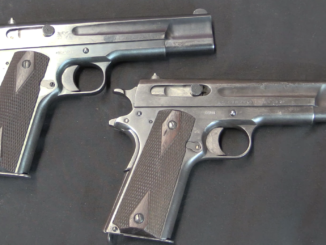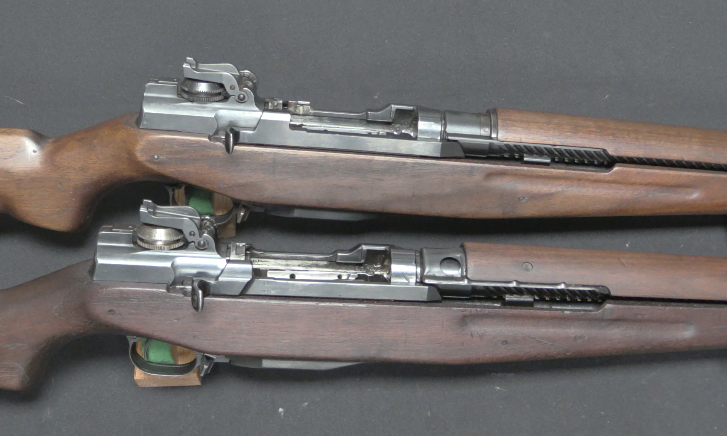The Schouboe is best known in the US as one of the pistols that competed in the 1907 Army pistol trials, unsuccessfully. It was designed in Demark by Jens Schouboe, whose much more notable accomplishment was the Madsen light machine gun. The Schouboe pistol was a simple blowback design chambered in .45 caliber, but used a special cartridge with a lightweight bullet (63 grains; an aluminum-jacketed wooden core) at a high velocity (about 1600fps). This is the reason is was dismissed form the US Army trials, as they wanted a pistol using the .new .45 ACP cartridge (230 grains at 800 fps). I was particularly impressed by the very simple disassembly procedure, which is faster than any modern pistol I can think of. This Julia auction includes two different Schouboe pistols; one is a standard example with metal grips (and missing its magazine), and the other is a fancy gold-inlaid example made for the President of Uruguay.
Related Articles

Conversion
Springfield .22 Rimfire 1911 Conversions at James D Julia
Unnumbered Slide Slide #24 Almost immediately after adopting the Colt/Browning Model 1911 pistol, the US military requested a .22LR conversion for training purposes. In 1913 Springfield Arsenal developed a conversion, but it was woefully inadequate. […]

Prototype
GX vs GY: What Are the Differences in Pedersen’s Garands?
In a last hopeful attempt to get a rifle adopted and produced for the US military, John Pedersen designed his own copy of the M1 Garand rifle in the late 1930s (approximately 1939). His toggle-locked […]

Antiques
Fenian Needham Conversion: Just the Thing for Invading Canada
The Fenian Brotherhood was formed in the US in 1858, a partner organization to the Irish Republican Brotherhood. The groups were militant organizations looking to procure Irish independence from the British, and they found significant […]

Actually this fellow’s name Schuboe reads like ‘Shoobow’. Ian, I will send you a May 1945 Copenhagen uprising photo, showing Danish underground soldiers with a 1912 Schoboe and a Suomi SMG for some Vintage Friday airing.
No “Schouboe” is older Danish spelling (not German), where sch- is an hard sk sound. Old surnames do not changed with spelling reforms. The moden Danish spelling would be Skovbo [which means “Forest-dweller”].
Schou is pronounced with a diphthong so “Skow” or “Skou” depending on how one choose to write that sound.
-boe is an older spelling of the modern -bo and that is NOT a diphthong, as the -e was silent. [Likewise the ending -by was formerly spelled -bye].
His name is pronounced “SKOW + bo” with emphasis on the first syllable.
The weak second syllable is with a short -o- like when you pronounced the board game “go” in Japanese.
Otherwise the May 1945 Copenhagen you mention is probably the photo from the Newspaper “Politiken” the 7th of May 1945, taken when the Danish Brigade on the 6th of May [just after the Germans has surrendered in Denmark the 5th of May] had arrived from Sweden and then on their way to “Rådhuspladsen” [Copenhagen City Square], they were shot at from the Vesperport building dispersing the cheering crowds. So they have afterwards taken position and was shooting (?) down Vesterbrogade, when the photo was taken.
The photo was discussed in the Nordisk Våbenforum”: https://www.nordisk-forum.dk/viewtopic.php?t=67951
Ian:
At elapsed time points 3:18 and 5:19 you show a view of the muzzle and this raises a question; it appears to have a polygon bore. Was this to accommodate the aluminum-jacketed projectiles or were other weapons of his design so configured? Just curious…
At 5:19, I clearly see standard land and groove rifling.
“The Schouboe pistol was a simple blowback design chambered in .45 caliber, but used a special cartridge with a lightweight bullet (63 grains; an aluminum-jacketed wooden core) at a high velocity (about 1600fps). This is the reason is was dismissed form the US Army trials, as they wanted a pistol using the .new .45 ACP cartridge (230 grains at 800 fps).”
Do you know original requirements for this trials? IIRC they were caliber equal .45 and some minimal muzzle energy level, so the Schouboe cartridge satisfy this objectives. I’m wondering about accuracy of this pistol – light bullets lost velocity faster than heavy and bigger-diameter bullets lost velocity faster than smaller-diameter, so I assume .45 Schouboe lost velocity especially fast.
You can see .45 Schoubue cartridges on municion: http://www.municion.org/Schouboe/45Schouboe.htm
Actually, the Schoeboe cartridge, which is at the heart of this design, is a pretty clever concept.
In many ways, it was a forerunner of modern-day “frangible” bullet rounds like the Glaser, CorBon, etc., relaying on high velocity to generate striking energy without the risk of overpenetration.
A 63 grain bullet at 1600 feet per second has a muzzle energy of 358 foot pounds (485j). When a bullet consisting of a thin gilding metal jacket, an aluminum forward core and a wooden after core hits someone going that fast, it will penetrate even heavy clothing. Once inside the body cavity, though, it will tend to mushroom, and when it turns over it will likely open up its rear end like a basin, if it doesn’t come apart entirely.
The result will be the sort of avulsed internal permanent crush cavity we today associate with a 5.56 x 45mm M193 Ball with the old 55-grain spire-point bullet, that tends to actually blow up in the body cavity.
I don’t think there’s much doubt that the “weak” Schoeboe round would be an effective “stopper”, based on internal trauma. I also suspect that after the cadaver and bullock tests the were done around that time, the Ordnance Board was concerned about whether or not such a bullet wold be considered a violation of the Hague Convention. I know the United States never actually signed on to it, but by and large our forces have always abided by it mainly to gain protection for any of our personnel who ended up as POWs.
I agree its penetration wouldn’t be up to that of the 230 grain hardball. And the Army was still thinking in terms of bringing down horses. (Brutal and inhumane, but sensible, as horsedrawn transport was used by all sides in both World Wars and especially so from 1914 to 1918.)
But in a situation where penetration had to be controlled, say where hostages were being held, or where it would pose an overall hazard (say, in an aircraft), the Schoeboe approach has a lot to recommend it.
BTW, the company’s name is pronounced “Dansk Wreck-ill Rifle Syndicate”. The second word is really the only one that isn’t pronounced pretty much as though it were written in English. “Madsen”, IIRC, was originally their telegraph address, just as “Parabellum” (“Prepare for War” in Latin) was DWM’s.
cheers
eon
Actually, it sounds more like the original 5.7×28mm round as used in the P90. The original round used a light plastic cored bullet fired at a high velocity.
For various reasons this was later changed to a heavier more conventional bullet.
Particularly because it’s a fairly early design, there’s trade offs with high speed but lightweight bullets though as alluded to.
There is a (originally French IIRC) THV bullets that use same super-light bullet concept. Stopping power is reported to be excellent and there is almost no risk of overpenetration. Due the bullet shape it also cuts through soft armor easily but rapidly loses velocity in tissue.